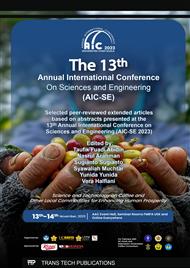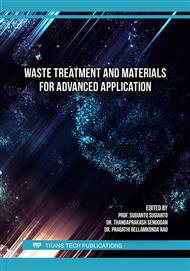[1]
A. I. Waly, M. A. M. Khedr, H. M. Ali, and I. Ahmed, "Chemical Functionalization of Cellulose-Poly (Glycidyl-Methacrylate) Graft Copolymer with Two Different Poly Amino Compounds," Egypt. J. Chem., vol. 63, no. 7, p.2673–2682, 2020.
DOI: 10.21608/ejchem.2020.26122.2522
Google Scholar
[2]
T. Aziz et al., "A review on the modification of cellulose and its applications," Polymers (Basel)., vol. 14, no. 15, p.3206, 2022.
Google Scholar
[3]
H. Y. Choi et al., "Thiol-functionalized cellulose nanofiber membranes for the effective adsorption of heavy metal ions in water," Carbohydr. Polym., vol. 234, p.115881, 2020.
DOI: 10.1016/j.carbpol.2020.115881
Google Scholar
[4]
J. A. Avbunudiogba, N. David, O. A. Meko, S. O. Eraga, and M. I. Arhewoh, "Extraction and Characterization of Microcrystalline Cellulose Obtained from Cocos nucifera Seed Pulp," vol. 8, no. 4, p.106–115, 2022.
Google Scholar
[5]
A. P. B. Mariano, Y. Unpaprom, V. K. Ponnusamy, and R. Ramaraj, "Bioethanol production from coconut pulp residue using hydrothermal and postalkaline pretreatment," Int. J. Energy Res., vol. 45, no. 6, p.8140–8150, 2021.
DOI: 10.1002/er.5544
Google Scholar
[6]
J. Chutrtong and W. Chutrtong, "ScienceDirect ScienceDirect ScienceDirect ScienceDirect Paper Paper for for Chromatographic Chromatographic Technique Technique from from Coconut Pulp Cellulose Coconut Pulp Cellulose Costing models for capacity optimization in Industry 4.0 : Trade-off," Procedia Manuf., vol. 32, pp.969-974, 2019.
DOI: 10.1016/j.promfg.2019.02.310
Google Scholar
[7]
L. Guo, D. Li, H. Lennholm, H. Zhai, and M. Ek, "Structural and functional modification of cellulose nanofibrils using graft copolymerization with glycidyl methacrylate by Fe2+–thiourea dioxide–H2O2 redox system," Cellulose, vol. 26, no. 8, p.4853–4864, 2019.
DOI: 10.1007/s10570-019-02411-2
Google Scholar
[8]
D. R. Tobergte and S. Curtis, "Graft Copolymerization of Methyl Methacrylate Onto Rice Husk," J. Chem. Inf. Model., vol. 53, no. 9, p.1689–1699, 2013.
Google Scholar
[9]
X. Liu, Y. Li, Z. Chu, Y. Fang, and H. Zheng, "Surface modification of bacterial cellulose aerogels by ARGET ATRP," J. Appl. Biomater. Funct. Mater., vol. 16, no. 1_suppl, p.163–169, 2018.
DOI: 10.1177/2280800018757337
Google Scholar
[10]
R. K. Sharma, R. Kumar, and A. P. Singh, "Metal ions and organic dyes sorption applications of cellulose grafted with binary vinyl monomers," Sep. Purif. Technol., vol. 209, no. August 2018, p.684–697, 2019.
DOI: 10.1016/j.seppur.2018.09.011
Google Scholar
[11]
A. Barakat, A. Fahmy, S. H. EL-Moslamy, E. M. El-Fakharany, E. A. Kamoun, and M. Bassyouni, "Cellulose nanocrystals from sugarcane bagasse and its graft with GMA: Synthesis, characterization, and biocompatibility assessment," J. Appl. Pharm. Sci., vol. 11, no. 2, p.114–125, 2021.
DOI: 10.7324/JAPS.2021.110215
Google Scholar
[12]
H. Abral et al., "Transparent and antimicrobial cellulose film from ginger nanofiber," Food Hydrocoll., vol. 98, no. May 2019, p.105266, 2020.
DOI: 10.1016/j.foodhyd.2019.105266
Google Scholar
[13]
R. K. Sharma and R. Kumar, "Functionalized cellulose with hydroxyethyl methacrylate and glycidyl methacrylate for metal ions and dye adsorption applications," Int. J. Biol. Macromol., vol. 134, p.704–721, 2019.
DOI: 10.1016/j.ijbiomac.2019.05.059
Google Scholar
[14]
B. Abderrahim, E. Abderrahman, A. Mohamed, T. Fatima, and T. Abdesselam, "Kinetic Thermal Degradation of Cellulose , Polybutylene Succinate and a Green Composite : Comparative Study," no. June 2018, 2015.
Google Scholar



